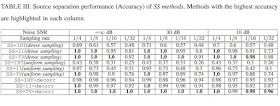On his Google + feed, Pierre Vandergheynst let us know that he and his colleagues :
Just released a new preprint on compressive source separation. The paper shows that you can perform source separation directly on compressive measurement. It's a great advantage for hyperspectral imaging or other modalities where datasets are huge. We also give theoretical guarantees on recovery. This is the first paper in a series: in this work we assume we know the dictionary of spectral signatures, but the next paper will deal with the blind case.
I also would like to stress that the paper comes with a reproducible research addendum: we provide the necessary code and data to reproduce our experimental results. It's all online and open. Use it, hack it, criticize, have fun. I really want to push this idea of providing code and data with all future papers of the lab.The whole package (paper + addendum) can be downloaded here: https://infoscience.epfl.ch/record/180911?ln=en
Compressive Source Separation: Theory and Methods for Hyperspectral Imaging by Golbabaee, Mohammad; Arberet, Simon; Vandergheynst, Pierre. The abstract reads:
With the development of numbers of high resolution data acquisition systems and the global requirement to lower the energy consumption, the development of efficient sensing techniques becomes critical. Recently, Compressed Sampling (CS) techniques, which exploit the sparsity of signals, have allowed to reconstruct signal and images with less measurements than the traditional Nyquist sensing approach. However, multichannel signals like Hyperspectral images (HSI) have additional structures, like inter-channel correlations, that are not taken into account in the classical CS scheme. In this paper we exploit the linear mixture of sources model, that is the assumption that the multichannel signal is composed of a linear combination of sources, each of them having its own spectral signature, and propose new sampling schemes exploiting this model to considerably decrease the number of measurements needed for the acquisition and source separation. Moreover, we give theoretical lower bounds on the number of measurements required to perform reconstruction of both the multichannel signal and its sources. We also proposed optimization algorithms and extensive experimentation on our target application which is HSI, and show that our approach recovers HSI with far less measurements and computational effort than traditional CS approaches.
All the codes supporting this paper are here.

No comments:
Post a Comment